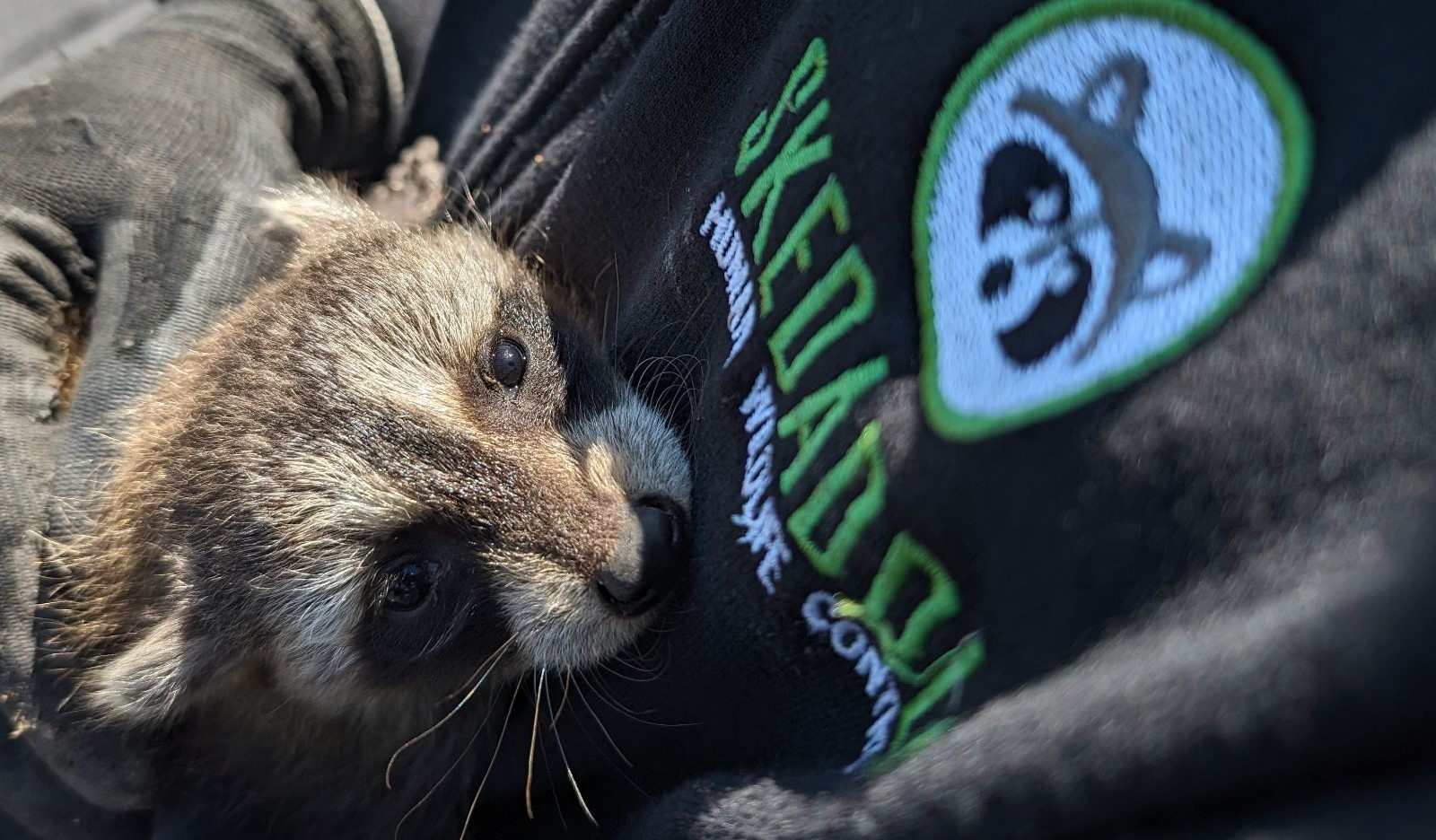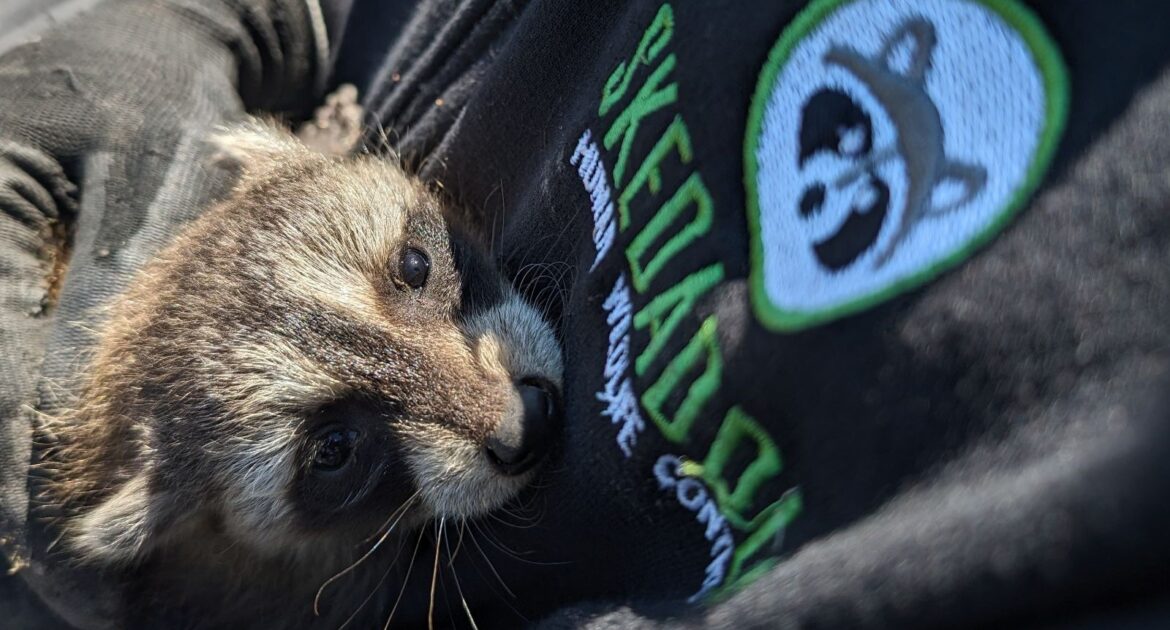Spring mornings greet us with the soft chill of dew-drenched grass, while cooler evenings remind us that winter isn’t too far in the past. For us, it’s a refreshing change. For raccoons, however, this season sparks a shift in their behaviour—one that could directly impact your home.
Understanding spring raccoon behaviour and how they adapt their routine through all the seasons can help homeowners stay ahead of these nocturnal guests. And if they do come a little too close for comfort, Skedaddle is here to help with wildlife control in Coquitlam.
Spring Raccoon Behaviour
Spring is a time of awakening. Trees are budding, days are getting longer, and animals are becoming more active—and raccoons are no exception. During this season, food sources become more plentiful after the challenges of winter. Raccoons are scavengers by nature, so they take advantage of the milder weather to explore neighbourhoods, overturn garbage bins, and forage for anything edible.
Spring also marks the beginning of raccoon birthing season. Female raccoons begin looking for safe, cozy places to have and raise their young. Often, homes provide the perfect refuge. Attics, crawl spaces, chimneys, and even eaves make excellent hiding spots where a mother raccoon can keep her newborn kits safe from predators. For homeowners, this can lead to unexpected noise and damage—and sometimes even strange, chattery sounds in the middle of the night.
The cooler mornings and evenings during spring also encourage raccoons to be more active in and around neighbourhoods. They may attempt to squeeze into spaces they normally wouldn’t during the hotter summer days when the weather keeps them less mobile. For homeowners, now is the time to stay vigilant about securing your property. Proper precautions can save you a lot of headaches down the road.
How Raccoons Access Homes in Spring
Because spring coincides with raccoons’ nesting season, they become incredibly resourceful in their efforts to gain access to your home. It doesn’t matter if it’s an old roof vent, a loose piece of siding, or an opening around a chimney—if there’s a way in, they’ll find it. And what may seem like a small hole to you could be enough for an adult raccoon. The following is a list of some of the most common entry points for a raccoon.
- Unsealed chimneys: Raccoons are excellent climbers and can easily scale walls to access chimneys. If yours doesn’t have a secure cap, it’s like an open invitation to a cozy raccoon party.
- Gaps in roofing or soffits: Loose shingles, gaps in the roofline, or damaged soffits are prime entry points. They’re small enough for a raccoon to squeeze through, but big enough to lead to a lot of damage inside.
- Attic vents: If vents aren’t properly screened, they can act as a highway straight into your attic. Raccoons love attics because they’re quiet, warm, and sheltered from predators.
- Open windows or doors: It’s rare, but if you leave a window open—especially near a tree or dumpster—an adventurous raccoon might decide to try its luck.
- Pet doors: Raccoons are smart and resourceful. If you’ve got a pet door, a curious raccoon might learn to push its way inside, especially if it smells food.
- Cracks or holes in exterior walls: Damaged siding or small holes in your home’s exterior can act as entry points. Once a raccoon spots a weak spot, they’ll dig, chew, or claw to make it bigger.
- Deck or porch openings: Open spaces under decks, porches, or sheds make perfect nesting spots. If they aren’t sealed up or reinforced, raccoons can get in and potentially dig their way closer to the house itself.
- Garage doors left ajar: If you forget to close your garage door or it doesn’t seal tightly, raccoons can sneak inside. Once there, they may find an entry into the rest of the house.
- Vines and tree branches: Overhanging branches or climbing vines act like ladders to your roof. From there, it’s just a matter of finding any weak spots in your home’s exterior.
- Exposed crawlspaces: If the access panels to your crawlspace are loose or missing, raccoons might move in before you even notice.
Once they’re in, you’ll likely notice signs of their presence.
- Scratching or thumping sounds in your attic? Check.
- Is insulation torn apart or displaced? Another key sign.
- Foul smells? Unfortunately, yes—those could also be due to raccoons.
It doesn’t stop there; raccoons tend to bring in debris like leaves and dirt as they build their den, and they can even create entry points by tearing or chewing through building materials.
This is where professional wildlife removal in Coquitlam, like Skedaddle, becomes crucial. Removing raccoons isn’t just about getting them out of your home; it’s about preventing future intrusions and ensuring every step is handled humanely. That’s exactly what sets our methods apart. Plus, we understand seasonal wildlife activity and will not only protect your home in the spring, but throughout all seasons.
Skedaddle’s Humane Approach to Raccoon Removal
At Skedaddle, we are committed to prioritizing the safety of both homeowners and wildlife. When it comes to raccoon removal—especially during spring when there’s a high chance kits could be involved—taking a gentle and humane approach is critical.
One of the key tools we use is our one-way doors. These ingenious devices allow raccoons to exit your home safely—but they’re designed to prevent them from getting back in. It’s a humane solution that ensures a mother raccoon can move her young to an alternate location outside your home without the stress of traps or the need for relocation. It’s all about working with these animals’ natural instincts while protecting your property at the same time.
For added protection, we also seal up potential entry points after the raccoons are gone. This step makes all the difference in ensuring the same issue doesn’t happen again. With our team’s expertise, we’ll identify vulnerable areas you may not have even noticed and secure them against wildlife invasions.
What About the Damage?
Removing raccoons is only part of the process. What they leave behind often tells a messy story. From shredded insulation to chewed wires and unpleasant odours, the aftermath of a raccoon infestation can be overwhelming for homeowners. But it’s also where our services truly stand out.
Skedaddle doesn’t stop at removing wildlife; we restore your home, too. Our team will clean up all traces of a raccoon’s presence and repair damage so your space feels brand-new. This can include sanitizing affected areas, replacing insulation that’s been torn apart, and addressing structural vulnerabilities. The goal is not only to restore your home to its original condition but also to protect your family from potential health risks that can arise from exposure to raccoon waste and nesting material.
The peace of mind that comes with knowing your home has been fully restored is just as important as its security. That’s why our restoration services are such an integral part of what we offer.
The Seasons Ahead—What to Expect from Raccoons
While spring makes raccoons more active in seeking shelter and food, their behaviour shifts with the seasons. Understanding these patterns can help homeowners anticipate potential challenges:
Summer: When temperatures rise, raccoons tend to become less active during daylight hours and focus on nighttime scavenging. Food is abundant in the warmer months, which means they might not be as determined to enter homes as they are during the spring. However, it’s still important to keep trash bins secured and maintain any preventive measures around your house. Remember, once a raccoon gets comfortable near your home, it may choose it as a winter shelter later in the year.
Fall: Fall is all about preparation. Raccoons take this time to fatten up before winter, which can lead to aggressive foraging behavior. They’ll again begin seeking out cozy spaces for hibernation-like shelter, potentially targeting attics and garages. This time of year is critical for homeowners to inspect their properties for gaps or vulnerable areas that raccoons could exploit.
Winter: Though raccoons don’t technically hibernate, they do go through periods of inactivity in the dead of winter when food is scarce. They’ll stay holed up in dens most of the time, venturing out only when necessary. If a raccoon has already chosen your home as its den, you might have to deal with disturbances even during the quieter winter months.
Preventative Measures for Homeowners In Coquitlam
There’s no better time than spring to take preventative action against wildlife issues. Start by inspecting your home for potential entry points—look for gaps in your roofline, damaged soffits, or any spaces around vents and chimneys. Installing sturdy screens or covers over vents can be an effective deterrent. Don’t forget to secure any outdoor food sources, like pet food or bird feeders, that could attract curious raccoons.
If you’ve noticed signs of raccoons on your property or suspect they’ve already made their way inside, don’t attempt to handle the situation yourself. Wildlife removal can be tricky and potentially dangerous if not done properly.
Skedaddle Is Here to Help In Every Season
Every season brings its own challenges when it comes to raccoons, but you don’t have to face them alone. Spring might be the season of renewal, but it’s also the perfect time to reclaim your home from unwanted visitors. Skedaddle’s humane wildlife removal techniques and expert restoration services ensure no raccoon is left behind—and neither is any damage.
If you’re hearing the telltale sounds of activity in your attic or finding torn-up insulation, don’t wait for the problem to get worse. Call Skedaddle Wildlife Removal in Coquitlam today, and we’ll help you restore both your home and your peace of mind.
FAQ’s
Why are raccoons more active around my home in the spring?
Spring is a season of renewal, and raccoons are busy preparing for warmer months. Cooler mornings and evenings can prompt them to seek warm, sheltered spaces—like your attic or crawlspace—to nest or raise their young. This seasonal shift often leads them to explore homes more than usual.
How does Skedaddle remove raccoons humanely?
At Skedaddle, we prioritize humane methods using one-way doors. These allow raccoons to exit your home but prevent them from getting back in. This gentle approach ensures they can relocate without harm, and you can rest easy knowing your home is raccoon-free.
What happens after the raccoons are removed?
Once the raccoons are gone, Skedaddle takes care of the cleanup and restores any damage they've caused. We’ll repair insulation, seal entry points, and clean contaminated areas to make your home safe and secure again. You’ll hardly know the raccoons were there!




